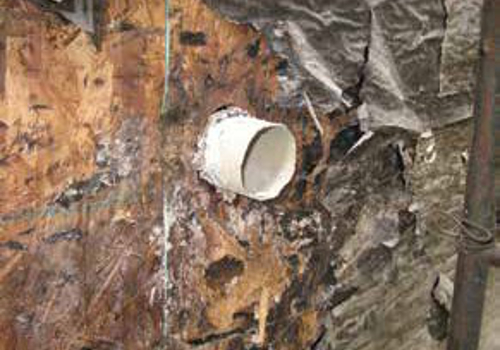A waterproofing “mistake” is the failure of a product or installation to perform given the specific environment. In layman’s terms, it is a leak. The same installation in another environment may perform as planned. But every day, our consultants observe installations that are contrary to industry standards or good practice.
Most of the installation problems we observe fall under the following :
- Not conforming to the plans and specs
- Not reading the instructions
- Improper theory
- Improper material for the conditions
- Incomplete thought process
- Obvious open conditions (holes)
- Improper material installation
- Incomplete waterproofing at interfaces
- Lack of coordination between trades
- Improper sealing of penetrations
- Reversed laps
Here are the top 10 waterproofing mistakes we see in the construction phase:
1. Contractor says, “I’ve done it this way for 20 years and I’ve never had a leak.”
If that were so, there would not be a need for waterproofing consultants. Building practices are changing rapidly, but the science to prove that those practices work often lags behind. Building envelopes are also getting tighter to reduce energy loss and to improve creature comforts. As a result, new products, methods and skill sets are emerging. Specialists work hard to stay on the cutting edge of technology in order to understand and advance the building envelope industry, recommending technological and scientifically proven systems.
2. Inexperienced installers, improper installations
Even a well-intentioned contractor or subcontractor may have inexperienced workers. Mock-ups, physical models of the waterproofing treatment, are important. By testing the mock-up, a waterproofing consultant can assist working through the complications of installations. It is important to have the actual installers involved in working the mock-up. Too often the bosses will prepare the mockup and there is a total disconnect when the workers install the actual work. There is not “one way” to properly install waterproofing, but there are a lot of ways to goof it up.
3. Poor drainage
Take advantage of daylight drainage observation whenever possible. It doesn’t make sense to install an elaborate waterproofing system when proper water management, slope and drainage can eliminate hydrostatic pressure and reduce the potential of water intrusion. Use gravity to your advantage to move water away from the building.
4. Discontinuous and incomplete waterproofing
One waterproofing system must tie-in properly with another. Waterproofing solutions that cover 99% perfectly can be a 100% failure. Most often, water intrusion occurs when different materials do not interface properly. Often the various trades will do their work, but not in a proper sequence or with a complete tie-in. A consultant can recommend the proper sequencing, procedures and interfacing.
5. Not understanding that waterproofing is a specialty
Even an experienced construction superintendent doesn’t always anticipate what must be done for waterproofing. Learning the waterproofing trade is a life’s work in itself. Waterproofing consultants have the experience, training and a knowledge base in this specific area.
6. Improper prep of materials for adhesion and durability
Proper preparation is the key to a successful installation. Protecting that installation is key to durability.
7. Material incompatibility
Dissimilar materials and chemistries can undo otherwise good work pretty quickly. Copper and galvanized metal don’t mix, nor do rubberized asphalts and PVC’s, nor do chlorides and reinforced concrete. Some other incompatibilities are more subtle but devastating; such as slightly moist conditions when installing most adhered membranes. New VOC regulations exacerbate this problem.
8. Tenant “improvements” and crazy-quilt repairs
Often, tenant improvements and other post-construction activities cause water intrusion problems. This happens when the existing system is not properly identified or understood. Consultants must be able to identify the system and products already in place in order to recommend a proper waterproofing integration.
9. Too much of a good thing
We often see a lot of good materials used on a project, in fact way more than necessary. Typically, what matters most is that the materials are used properly, not the quantity that is used. Your consultant can advise you on the materials necessary for optimum performance.
10. Regular communication is key
A waterproofing consultant is a member of your team. They are not “building police,” so there is no reason to be anxious or reluctant to call with any question or concern. Staying in regular contact with your consultant is important. On construction projects, site visits are also important. For example, your phone call or correspondence may cover an important issue, but a site visit will add the benefit of our observations. Often our company is asked to visit the site for one issue and we observe a host of other issues that have been overlooked. Water infiltration and related problems in buildings are one of the leading causes of defective construction issues. Waterproofing is our specialty. Our consultants are seasoned professionals, each with a developed critical eye based on comprehensive construction experience, combined with extensive continuing education and specialty certifications.

